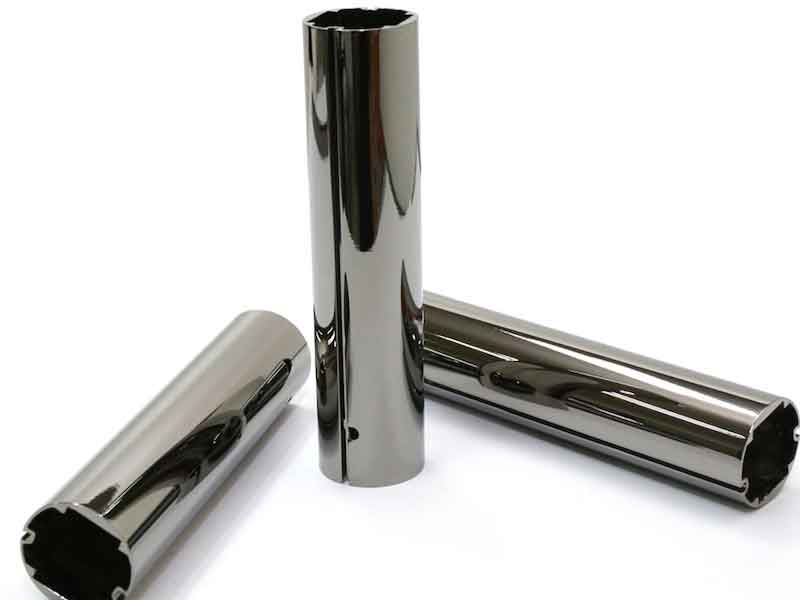Decorative trivalent chromium plating was perhaps the first big alternative developed to replace a standard plating process.
 Stephen F. Rudy CEFEver since the late 1920s, decorative chrome and hard chrome plating from chromic acid baths have been accepted plating operations. Over the years, nothing was developed to replace either decorative or hard chrome plating on an equal basis. Electroless nickel can approach the hardness characteristics in accord with a specific post-bake treatment. Some work has been accomplished utilizing alloy plating processes, achieving deposits of a similar color to a standard hexavalent chrome flash. Only color is stipulated, not with regard to equalizing or surpassing corrosion protection or deposit hardness.
Stephen F. Rudy CEFEver since the late 1920s, decorative chrome and hard chrome plating from chromic acid baths have been accepted plating operations. Over the years, nothing was developed to replace either decorative or hard chrome plating on an equal basis. Electroless nickel can approach the hardness characteristics in accord with a specific post-bake treatment. Some work has been accomplished utilizing alloy plating processes, achieving deposits of a similar color to a standard hexavalent chrome flash. Only color is stipulated, not with regard to equalizing or surpassing corrosion protection or deposit hardness.
Hard chrome, with its relatively infinite deposition thickness, release lubricity, and hardness, is still uniquely positioned based on the deposit characteristics, thickness ranges, and overall utility. Military, aerospace, aircraft, drilling equipment, the printing industry are some of the commercial applications, along with many others, where hard chrome from the hexavalent bath is the mainstay. Work, however, is ongoing to provide the finishing industry with a viable replacement to hexavalent-based hard chrome.
The interest in decorative plating from the trivalent chromium-containing bath (as opposed to the traditional hexavalent) may have been sparked by the following basic chemical equations:
Cr(VI)+ + 6 electrons = Cr metal and Cr(III)+ + 3 electrons = Cr metal
The first equation requires six electrons for the reduction of the hexavalent chromium ion to metallic chromium.
The second equation requires three electrons for the reduction of the trivalent chromium ion to metallic chromium.
The difference in efficiency between both reactions (termed oxidation/reduction) is 2:1 in favor of the trivalent chromium reduction to the metallic state. Considering this difference, it was clear that several operating benefits would be achieved by switching from hexavalent decorative to decorative trivalent chromium plating. Perhaps the main benefit realized in plating is:
Overall Efficiency
Hexavalent chrome achieves 10-15% efficiency (based on ratio and catalyst system, along with wasteful electrochemical side reactions). Trivalent chrome readily doubles this to 30%. This is a big, important, industrially desired achievement.
Concurrent with process development, health and safety in the workplace became a critical issue. Clinical studies, coupled with personal exposure over time, confirmed a definite health risk to long-term exposure to chromic acid solution and airborne mists. That is why OSHA and EPA specified approved ventilation, mist suppression, and protective clothing. Hexavalent chromium was determined to be a carcinogen. This was, from a health and safety issue, a big reason to eliminate, where possible, hexavalent chromium compounds. This was another, perhaps bigger, reason to use trivalent chromium salts. Trivalent chromium compounds are not carcinogenic. In fact, most multivitamin products contain trivalent chromium, essential for overall health.
Incidentally, the trend of replacing hexavalent chrome-containing processes continues today and will for many tomorrows. For example, we have seen the installation of trivalent chromium passivates (the 1980s) meeting RoHS and the newer REACH directives (late 1990s to early 2000s). Returning to trivalent chromium plating, these are some of the benefits achieved in the operation, as opposed to hexavalent. The benefits listed are actual, from field results covering different proprietary processes and operations:
- Production capacity can be doubled. More parts can be racked with less space in between. Deposit throw and efficiency are markedly improved, where the nickel tank may become the limiting factor to production output.
- Chrome metal as (Cr+3) in the bath ranges from 1-3 oz/gal (7.5-22.5 g/l). Post plate rinsing is more effective, with less metal having to be waste treated. This compares to hexavalent chrome baths, which typically contain 10-17 oz/gal (75-128 g/l) of chrome metal as (Cr+6), in a viscous, difficult to rinse solution.
- Shading, whitewash, and deposit burning are eliminated.
- Make and break electrical contact is no longer a problem. A rack or flight bar can be lifted and inspected, then returned to continue plating, similar to handling parts in a nickel bath.
- The previous point introduced our industry to trivalent chromium barrel plating systems.
- It is possible to strip the trivalent chrome deposit in 30-50% Hydrochloric Acid, rinse well, followed by directly plating over the now activated nickel deposit. Even in extended line transfer times, Cr(III) solution is more accepting of nickel that may be sufficiently passive to a Cr(VI) bath.
- There is much less wasteful gassing. No corrosive mists. No requirement for a fume suppressant. However, wetting agents are used to support uniform and non-striated deposits while forming a thin surface blanket.
- Some metal contaminants can be dummy plated to purify the bath. Hexavalent baths cannot dummy plate out metallic contaminants. The only remedies are to increase the chromic acid concentration or have the bath undergo a specific membrane purification electrolysis process or porous pot.
- Lead anodes are eliminated. Lead is then no longer a heavy metal contributing to health issues or required annual reporting.
- AC ripple is no longer a critical factor. 5-10% ripple, similar to nickel, can be tolerated. Rectification is simpler and much less expensive.
- Elimination of hexavalent chromium in waste treatment. In most applications, simple alkaline precipitation of Cr(OH)3 (trivalent chromium hydroxide) is all that is required as part of the process. Traditional Sodium Metabisulfite reduction of Cr+6 to Cr+3 is eliminated in the waste treatment of Cr+6. This is in combination with reduced sludge generation falling under F006 regulation.
Each of these examples does relate to cost savings, which can readily offset some rising costs in the current economic climate. It certainly helps both finisher and the customer to be more competitive.
Inception and Advances
Commercially feasible decorative trivalent chromium plating was introduced in the early 1970s by the Albright and Wilson Company. Being a leading chemicals manufacturer in the UK, they realized the potential benefits afforded by the concept of plating chromium from a trivalent bath. Their introduced bath consisted of chloride and sulfate salts (important for conductivity), Cr (VI) inhibitors, and purifiers that would remove precipitated metal contaminants via an operating bath filter. With any new process, shortcomings placed demands on the need for overall process improvement.
Another UK-based worldwide supplier, W. Canning Materials Ltd., dedicated a great deal of R&D, coupled with innovative process modifications. Canning understood the major problem of deposit color darker than true hexavalent chromium. The problem was not so much for stand-alone parts. It was a major problem where parts from both plating processes would have to be matched, such as plumbing and hand tools. The biggest initial problem associated with trivalent chromium plating was how to overcome the obvious oxidation of Cr (III)+ to Cr(VI)+ as an anode recognized oxidation reaction. The unfortunate formation of Cr(VI)+ quickly resulted in problems controlling desired deposit color and associated contamination such as darkened deposit color lack of coverage, resulting in line shutdown (unpredictable tendency to zero production output). The biggest initial problem associated with trivalent chromium plating was how to overcome the obvious oxidation of Cr (III)+ to Cr(VI)+ as an anode recognized oxidation reaction. The introduction of reducing agents and related chemical purifiers helped, but only if extensive service and trained personnel spent quality time monitoring the process. The next step in anode design was introducing a novel anode concept. Canning introduced the technology of the lead anode being shielded from the actual plating bath. The lead anode was placed in a polypropylene box containing a conductive solution of dilute sulfuric acid, with the anode facing a semi-permeable membrane (commercially as Nafion). Its outstanding properties are widely used in membrane technology. For readers interested, Walther Grot of Dupont discovered Nafion in the late 1960s. Only hydrogen ions from water electrolysis inside the box could penetrate and pass through the membrane, migrating to the cathode, thus completing a plating circuit. This was a successful approach to eliminate the formation of Cr(VI)+. However, over an extended time, many boxes in the field leaked, thus not accomplishing their intended purpose on an ongoing basis. The problem was not the membrane; it was the sturdiness and service of the box. There was also the initial capital expense of the membrane and care not to damage it in stepped The Frederick Gumm Chemical Company. Gumm’s respect for innovative, quality technology and products spearheaded a practical solution. Their corrective action was to install anodes having a precious metal coating. Not new, but not having beforehand been considered in Cr(III) plating. By eliminating the box and membrane concept, the inert anode achieves a reasonable service life, measured in years, greatly stabilizing the bath chemistry for continued quality plating. There is still the cost of the precious metal coating and the eventual requirement to re-coat the anode base material. But these anodes were found to stabilize the process, establishing the cost savings of Cr (III), thus leading to a reasonable payback to recoat the anodes.
Improvements to stabilizers and purifiers have also enabled platers to operate a different based trivalent chrome chemistry bath, using carbon anodes, in sulfate and chloride systems. Much additional innovation was achieved by quality suppliers and innovators in the early to the mid-2000s, providing finishers with generally satisfactory Cr(III) decorative plating processes, barrel, and rack.
Detailed previously were several excellent advantages to decorative trivalent chrome plating as opposed to the hexavalent chrome counterpart. Are there any disadvantages? The following are field acknowledged:
- Thickness. In chromic acid-based systems, the deposit thickness is infinite. It relates to a parabolic graph. Decorative trivalent chrome thickness is self-limiting, approaching 0.127-1.27 microns (0.000005-0.00005 inches). For decorative thicknesses, Cr(III) and Cr(VI) deposit thickness ranges are similar.
- Passivation. Trivalent chromium solutions do not passivate unplated steel surfaces (such as inside unplated tubing), as does chromic acid.
- Stripping. Trivalent chrome plated parts, as I am accustomed to, are not cleanly and completely stripped anodically in the electrocleaner. Rather, 30-50% Hydrochloric Acid is required for a clean, complete deposit stripping.
- Deposit Color. From my experience, trivalent chrome deposits range from slightly darker than hexavalent chromium to almost a pewter appearance. In some customer requirements, a darker deposit color is preferred, whereas Cr (VI) only offers one color, no variant. A big misnomer is a mistaken belief that trivalent chrome deposits can be a dead-even match to the hexavalent chrome deposit color. The crystalline deposit structures of both differ and, as such, refract light differently. In addition, trivalent baths co-deposit organic additives.
Trivalent chrome baths seem to have been developed in a similar maintenance structure as for nickel baths. Trivalent chrome additives include a source of ready-to-plate metal, brighteners, stabilizers, buffers, wetting agents, and purifiers. pH is an important measurement, and its range is critical to optimum deposition and achieving deposit color. Normally two additives are dosed per ampere-hour. Wet analysis in conjunction with hull cells typically comprises bath and deposit maintenance. Carbon filtration with the option of hydrogen peroxide is important to minimize organic contamination. Dummy electrolyzing or ion exchange is used to remove metallic contaminants.
Decorative trivalent chrome plating has advanced in reliability, understanding, and process application. Acceptability has been across many consumer and industrial requirements. Health and safety issues make it a reasonable and wise selection. Trivalent chrome fits rather well into RoHS and REACH directives. The next big improvement in chrome plating would be commercially feasible hard chrome plating using trivalent chromium-based plating solutions.
Stephen F. Rudy, CEF, is president of Chem Analytic and has written extensively about the finishing industry. Visit www.chemanalytic.com or call him at 917-604-5001.



































